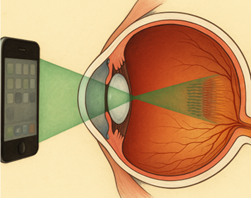Human Factors in Retina Display
In 2010, Apple introduced the iPhone 4 with a new feature called the Retina Display, making a leap forward in electronic devices. Two things stood out to me: first, Steve Jobs’s remarkable ability to market and explain complex technologies in a simple, engaging way; and second, the subtle but crucial role of human factors in the design and development of electronics.
If you want to see Job’s marketing skill in action, watch his speech here: https://www.youtube.com/watch?v=Hq8j5vsqCCo.
In this blog, I want to explain the Retina Display from a human factors perspective.
326 PPI
When the Retina Display was launched, Apple highlighted its pixel density: 326 pixels per inch (PPI). Jobs explained that beyond roughly 300 PPI, the human eye can no longer distinguish individual pixels at a normal viewing distance. But why is this the case?
How the eye processes images

- Rods are more sensitive in dim light and help detect shapes and motion.
- Cones function in brighter light and are responsible for color vision and fine detail.
Our ability to distinguish two separate points of light – visual resolution – depends on the spacing and activation of cones. On average, the human retina has about 6 million cones, most densely packed in the fovea centralis, the region responsible for sharp central vision. For people with 20/20 vision, the resolving power is about 1/60 of a degree. This corresponds to a resolution of around 60 pixels per degree of visual angle. If two pixels fall within this limit, the eye perceives them as one. This physiological constraint is what the term Retina Display leverages.
Visual Angle and Pixel Density
The visual angle is calculated from the size of an object and the distance from the eye. It determines how large the object’s image appears on the retina.
Assume most people hold a phone about 10 inches away. At that distance, one degree of visual angle spans about 0.175 inches on the screen. With a pixel density of 326 PPI, the iPhone 4 provides about 57 pixels per degree, which is very close to the 60 pixels per degree that humans can resolve.
In other words, the iPhone 4 was designed to align with the biological limits of the human eye. Today, with advances in technology, larger screens, and intense market competition, many electronics boast much higher PPI. Yet the underlying idea – leveraging human factors to design products and tuning that into a market advantage – remains a valuable lesson worth learning.